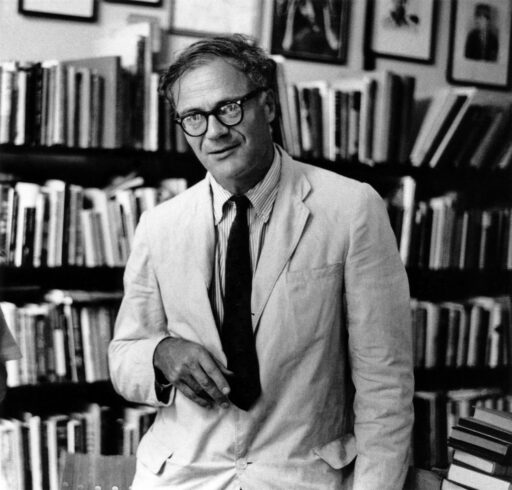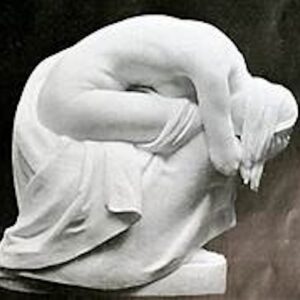It is startling how little Robert Lowell is read these days, considering he was one of the most prolific and versatile poets of the twentieth century. I, myself, came to him circuitously via Dana Gioia’s memoir Studying with Miss Bishop and my daughter’s recent obsession with Sylvia Plath. Nevertheless, the poetic bookends which span thirty years of his life’s work, the first poem of Lord Weary’s Castle, “The Exile’s Return,” and the last poem of Day by Day, “Epilogue,” have a lot to say to us today. Considered together, they shed light not only on Lowell’s development as a poet, but also on what it means to be possessed by a religious-artistic vision.
Lowell’s “Epilogue” in Day by Day, published just before he died in 1977, begins with a nod to “those blessèd structures, plot and rhyme.” “Blessèd”—an interesting, archaic choice for a poet who had all but disowned his earlier commitments to both religious and poetic formalities. His Pulitzer-prize winning Lord Weary’s Castle, written in 1947 when he was only thirty, bore a Latin prayer from the Mass for finding the body of St. Stephen as its epigraph and held within its pages what many at the time believed to be masterpieces of poetic architecture built with nothing but “plot and rhyme” to stand and deliver its post-war prophetic vision. Thirty years later, “Epilogue” goes on to say that these structures are “no help to [him] now,” so why would Lowell still venture to call them “blessèd”? And, if not “plot and rhyme,” then what was Lowell, at the end of his life, arguing to be the essential components of the poetic endeavor? Only a close reading of both poems might deliver some semblance of an answer.
The basis for “The Exile’s Return” is a borrowed plot from Thomas Mann’s 1903 novella, Tonio Kröger, about an exiled artist who returns from Paris to his hometown in Northern Germany. Much like Mann himself, the character of the novel is split between his northern Puritanical father and his artistic, Catholic mother from “Rhineland,” the lush, green region once part of the heroic Roman past. Robert Lowell, a recent convert who at the same time was ravaged by his own bipolar disorder and the collective consciousness of modern man, saw the plot of Tonio Kröger as an opportunity to rhyme himself onto the page with the backdrop of World War II’s desolation. And rhyme he did. A total of twenty-four lines, the poem is built with two sets of rhyming sestets and quatrains of iambic pentameter (with a trimeter crowning the end of each sestet) before a rhyming quatrain rings in the last images of hope for a new poetic, post-war vision.
Not only is the poem heavy with a sort of rigid, near stony structure, but the predominant motifs themselves are structures. Architecture: the “Hôtel De Ville, where braced pig-iron dragons grip / The blizzard to their rigor mortis,” a bell, a stripped spire, timber and lumber, the Holstenwall Hotel in Hamburg “where torn-up tilestones crown the victor,” not to mention the “gray, sorry and ancestral house” to which the exile returns and the “dynamited walnut tree” which causes him to cower. Reading the poem over again, I find the images seeming to stiffen like old wartime photos, stuffed in a box, “garish and grouped,” Lowell’s later poem “Epilogue” might have named them, looking back. But, despite these “lurid” details, “The Exile’s Return” also tells us what we will not see. We “will not see / Strutting children or meet / The peg-leg and reproachful chancellor / With a forget-me-not in his button-hole.” Hitler had already killed himself and his marching youth had scattered by the time the British rolled in to liberate Lübeck. What, then, does Lowell want his reader to zoom in on in the poem’s last turn? The flowers. “Lily-stands / burgeon the risen Rhineland,” symbols of Mary, the “blessèd” mother of Christ, and her son’s spring-time resurrection. And who, apart from us, looks? “A rough / Cathedral lifts its eye.” Pleasant enough? Perhaps, but only for those who, instead of abandoning all hope, retain a tiny glimpse of it, and (“Voi ch’ entrate” if you know your Dante) have the courage to enter.
You might ask what Lowell would later say about this glimpse of religious hope so beautifully rendered in the opening poem of Lord Weary’s Castle. At first read, “Epilogue” seems a poem of despair—despair at the help of “plot and rhyme” despite calling them “blessèd.” In contrast to the formal rhyme structure of “The Exile’s Return,” “Epilogue” is in the vein of William Carlos Williams, the colloquial, unrestricted verse which marked Lowell’s famous Life Studies. Out of twenty-three lines (one short of our first bookend’s twenty-four), only lines 7 and 8 rhyme, ending with “light” and “write.” Tricky Lowell, are you trying to tell us something? It can’t be coincidence: the only two lines in an entirely free verse poem that begins by naming rhyme “blessèd”? Perhaps the poetic vision of “Epilogue” hasn’t fully abandoned rhyme in order to communicate the most important point he’s making—that to write is to “write with light,” to get at the emotion and feeling of an experience and to curb what might make the representation of it too stiff, imitative, photographic.
But what of plot? Has Lowell, at the end of his life, truly despaired of story to inspire his poetry, also? The poem’s insertion of a question mark at the end of line 4 (“something imagined, not recalled?”) seems ambiguous. What does Lowell want? To write “something imagined” or “recalled”? Whether working with the borrowed plots of his earlier writing or the personal memories of his later “confessional” poetry, it seems Lowell never, in fact, abandoned plot, though he wants to ensure that it is “heightened from life, / yet (not) paralyzed by fact.” In the Miltonesque phrase of line 14, “All’s misalliance,” Lowell delivers the lowest blow of the poem—a confession of incompetence to ultimately hold these two in tension. But, as in the last quatrain of “The Exile’s Return,” the poem turns toward hope. “Yet why not say what happened?” Lowell, didn’t you say that plot was “no help to [you] now”? “What happened” seems “plot” enough for most readers. And if that isn’t perplexing enough, Lowell then delivers an almost shocking religious plea (shocking, I say, because by the end of his life, he had all but renounced explicit religious practice). Lines 16-17 read, “Pray for the grace of accuracy / Vermeer gave to the sun’s illumination.” In place of the exile’s “lily-stands / burgeon[ing] the risen Rhineland,” “Epilogue” pivots its readers toward prayer and the light “stealing like the tide across a map / to his girl solid with yearning.”
The writer’s ultimate task, the poem seems to say, is to accurately portray an experience, not in the way a photographer takes a snapshot, but with all the emotion and longing of the “painter’s vision” which lifts art from crude imitation. To the question of whether “plot and rhyme” can help us in this work, “Epilogue” seems ambivalent, but one thing hadn’t changed for Lowell after thirty years of manic-depression and poetic vision. He still wanted to excise the first part of Dante’s infernal warning. Don’t “abandon all hope.” Like the cathedral in “The Exile’s Return,” he wanted us to lift an eye, no matter how “threadbare” its art may be, “poor passing facts” as we are, and name the experience of yearning.
Brooke Ramsey is a school administrator and MFA candidate who, when not putting out fires for her family, can be found on a big Texas porch reading the medieval mystics or wrangling her first novel into its final form. You can also find her on Twitter @BrookeAshRamsey





